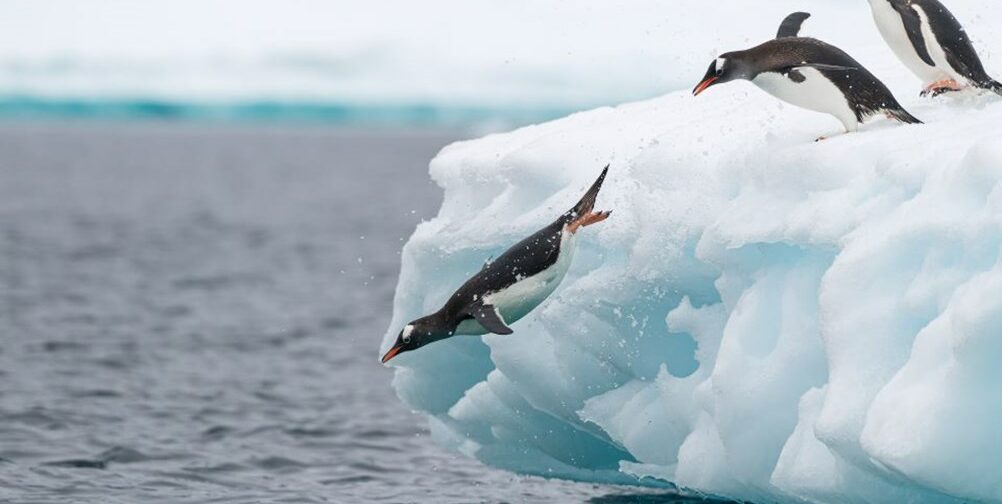Climate change is killing off the penguins, by … making too much ice. As in “Antarctica penguins: How too much ice triggered population decline.” Which differs remarkably from the settled science of 10 years ago which declared “Melting Sea Ice Threatens Emperor Penguins, Study Finds”. So you can see that there’s no way out of this climate extinction maze. Even though “The U.S. Fish and Wildlife Service granted federal protections to the world’s tallest and heaviest penguin species Tuesday” which will come as a great relief except for the fact that any Emperor on American territory is one lost penguin. Or in a zoo or an aquarium where it hardly needs federal protection. Meanwhile they’re not endangered where they actually live.
If you’re wondering how best to kill off a penguin, rhetoric is always useful and apparently ice comes in handy too. Thus the BBC reports breathlessly that too much Antarctic ice threatens that cute penguin. No, not that cute penguin the mighty Emperor. That cute penguin the adorable Adélie.
See, on November 22, 2022, it blared “Antarctica penguins: How too much ice triggered population decline” and shows a besmirched Adélie (don’t ask) on the verge of being iced. And if you’re wondering how too much ice can be a problem when the ice is melting, well, with climate change nothing is impossible. Too much ice puts one penguin on ice, and too little leaves another all at sea.
When hunting penguins it’s also desirable, evidently, to carry an 8.5 gauge warming scenario. For as Roger Pielke, Jr. noted of the latest deposing of the emperor version, “On listing of the Emperor Penguin under the ESA, I have no comment on listing decision itself/ I note it depends upon characterizing with no justification RCP8.5 as a ‘plausible’ scenario, not BAU, not worst case, apparently somewhere in the middle”.
The bodies are buried under a significant snowdrift here, because the actual listing decision by the USFWS defers justification of this wacky scenario as “plausible” to a separate paper, by the USGS. And if you’re the USGS (United States Geological Survey), you take pains (see p. 10) to disarm critics by admitting RCP8.5 is not “business-as-usual”, only to say that it is:
“RCP8.5 represents a future that could be consistent with limited or no climate change mitigation policies…. whereas RCP8.5 is generally associated with higher population growth, less technological innovation, and higher carbon intensities within the global energy mix, a wide range of future socioeconomic assumptions could be consistent with its outcomes. In other words, RCP8.5 is not necessarily a business-as-usual scenario (for example, Hausfather and Peters, 2020), but neither is it a worst-case scenario. RCP8.5 is simply representative of a plausibly higher level of GHG concentrations in the atmosphere, broadly consistent with ‘high warming’ scenarios modeled by previous global climate assessments”.
Baloney. RCP8.5 is, among other things, a scenario where global coal use skyrockets as global economies collapse, a combination that seems highly implausible. And if you treat it with the contempt it deserves, guess what? “The projected decline in the global population of emperor penguins is much less under the low-emissions scenario”. Which will never do.
Of course emperor penguins are bound to be doomed by climate change because they are noble and photogenic. As the Washington Post story bidding this brave beast farewell rhapsodizes:
“It is the only animal that dares to breed during the Antarctic winter. It endures gale-force winds and freezing temperatures to lay and protect a single egg. Now climate change threatens Antarctica’s emperor penguin with extinction, the U.S. Fish and Wildlife Service declared Tuesday, as melting sea ice upends the habitat it needs to breed, feed and protect itself from predators. ‘This listing reflects the growing extinction crisis,’ Martha Williams, the federal wildlife agency’s director, said in a statement, as the agency gave the iconic seabird protection under the Endangered Species Act. ‘Climate change is having a profound impact on species around the world.’”
As we’ve noted before, climate alarmists mastered time travel long before the rest of us. In this case the listing of the penguin is due to something that might happen to it many decades from now, not anything currently happening. In fact, as the writer eventually spits out like a half-digested fish for a hatchling:
“While sea ice around Antarctica has proved more durable than ice near the North Pole, nearly all emperor penguin colonies in the southern continent would be pushed to the brink of extinction by the end of the century without dramatic cuts to global greenhouse gas emissions, scientists projected last year…. Right now, the penguin’s population appears stable, with between 625,000 and 650,000 birds shuffling around Antarctica.”
So we’re talking about the profound impact climate change is already having 80 years from now. And pay no attention to that durable ice behind the Antarctic Circumpolar Current because, according to “scientists”, it’s not there later in a computer: “Climate models project significant declines in Antarctic sea ice to which the emperor penguin life cycle is closely tied”.
If you follow the link to what “scientists projected last year” you wind up at a paper, from which the last quotation is drawn, whose Abstract starts “Species extinction risk is accelerating due to anthropogenic climate change”. And if you didn’t know risk could accelerate, well, you’re right because it can’t. It can rise. But there’s a difference between accelerating rising risk in a computer and actual counting of birds on the Earth. As BirdLife International also explains of Aptenodytes forsteri, “The current population trend is considered stable”.
NBC concedes the point in a story that exhibits no deliberate skepticism, saying “The [USFWS] wildlife agency said a thorough review of evidence, including satellite data from 40 years showed the penguins aren’t currently in danger of extinction, but rising temperatures signal that is likely.” Then, to be safe (unlike the penguins) it went:
“Tuesday’s designation was described as a warning that emperor penguins need ‘urgent climate action’ in order to survive by Shaye Wolf, the climate science director at the Center for Biological Diversity. ‘The penguin’s very existence depends on whether our government takes strong action now to cut climate-heating fossil fuels and prevent irreversible damage to life on Earth,’ Wolf said.”
As to what’s really going on, the World Wildlife Fund admits that “There are approximately 595,000 adult Emperor penguins in Antarctica. But due to a lack of research, there is still so much we don’t know about these magnificent polar creatures.” Like, say, how many there were 30 years ago, or 100. And of course how many there will be in 30 years. We just made that bit up.
As Susan Crockford snarked in August 2020:
“Emperor penguin (Aptenodytes fosteri) populations in 2019 were found to have grown by up to 10% since 2009 – to as many as 282,150 breeding pairs (up from about 256,500) out of a total population of over 600,000 birds (Fretwell et al. 2012; Fretwell and Trathan 2020; Trathan et al. 2020) – despite a loss of thousands of chicks in 2016 when an ice shelf collapsed. Yet, biologists studying this species are currently petitioning the IUCN to upgrade emperor penguins to ‘Vulnerable’ (Trathan et al. 2020), based on models that use the implausible and extreme RCP8.5 ‘worst case’ climate change scenario (e.g. Hausfather and Peters 2020) that polar bear biologists find so compelling.”
Of course the usual suspects turn it into bad news. Over at TheScientist they said of this apparently reassuring update that:
“High-resolution satellite imagery has documented the existence of 61 Emperor penguin colonies in Antarctica, increasing the known number of colonies in the region by 20 percent. The findings, published yesterday (August 4) in Remote Sensing in Ecology and Conservation, relied on streaks of the penguins’ rusty red guano captured in images of sea ice taken from space. While the bump in numbers is welcome news to conservationists, the findings come with the caveat that these new colonies, and indeed the species itself, are susceptible to climate change.”
Or at least to climate change hysteria. And incidentally if you want to get run out of Climate Town altogether, we recommend that you quote this line from Wikipedia about a dramatic decline in Emperor penguin numbers:
“Population declines of 50% in the Terre Adélie region have been observed due to an increased death rate among adult birds, especially males, during an abnormally prolonged warm period in the late 1970s, which resulted in reduced sea-ice coverage.”
Abnormal warmth in the 1970s? Next you’ll be claiming a hiatus after 2001 or something.



"And if you didn’t know risk could accelerate, well, you’re right because it can’t. It can rise."
If the rise in risk per period of time is increasing with time, that's acceleration. It's not happening, but I'm not sure why it is deemed impossible.
There is a limit to the amount that a risk can rise because it can't exceed 100 percent - once it reaches that, it's no longer a risk, it's a certainty. This gives a practical limit also to risk acceleration, because too much acceleration and the risk quickly reaches 100 percent, whence further acceleration is meaningless. But if the acceleration is sufficiently low that the resultant rise can go on for a long time, then any discussion of risk acceleration is purely academic - as in fact is this comment.
The amount of ice has nothing to do with penguin populations. Spring storms which breaks up the ice and allows the penguins to reach their rookeries are the factors that count. If Antarctica only receives half the ice as normal it is still too far for a penguin to walk. If the ice doesn’t get broken up penguins will start to walk and die.